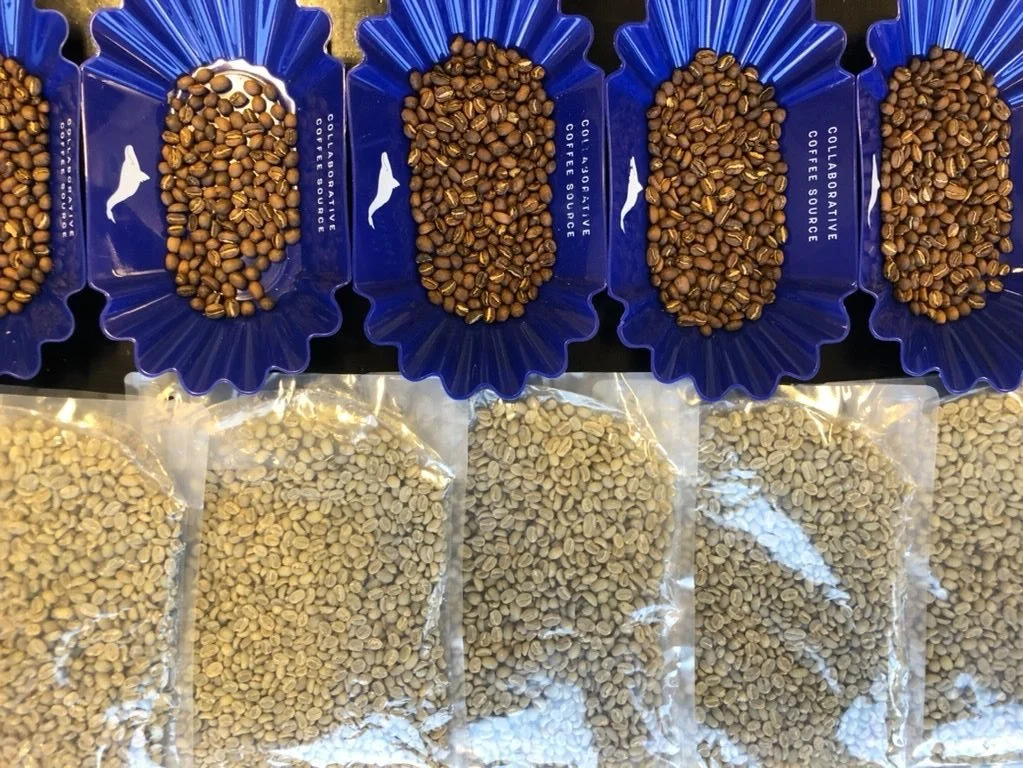Announcing the first in a quarterly series of cuppings at Bay Area CoRoasters, Berkeley, California: Tuesday Dec 5, 10am. See below for details and reserve your space on our Facebook page.
Co-roasting spaces such as Bay Area CoRoasters (or CoRo for short) are crucial businesses in the specialty coffee industry, providing an entry into the expensive business of roasting. Co-Ro offers memberships to coffee companies who then receive scheduled time on one of the four roasters on their production floor of their West Berkeley space.
An affordable beginning for new roasters
Co-roasting spaces give young companies time to practice, learn and build their business, before making the large investment of time and money in finding their own space, setting up machines, and acquiring the necessary permits.
“Our goal is to provide all of the infrastructure and capital intensive equipment for you to start a coffee business,” said Floy Andrews, co-founder and CEO of CoRo. “All of that investment is shared by different brands.”
One of four roasters available on the CoRo production floor. Image courtesy of Bay Area CoRoasters.
CoRo is also in a position to keep their roasting space up to date. “We’re really focused on having the newest technology,” Floy said. For example, “we’re switching out the afterburner with a thing called a Vortex which is a water quench mechanism. It collects the dirt in the smoke, and its strained into a bucket. It’s not toxic - it’s actually good for your plants. Afterburners release a lot of CO2 and [the Vortex] aligns more with the values of Co-Ro.”
Building a Coffee Community
But CoRo is so much more than simply an affordable way to roast. In keeping with the spirit of the Bay Area where they are located, CoRo has a mission to create a community. In addition to the four roasters available, the CoRo space offers members a QC lab and a cupping room. Here they hold events and offer their members training and development on their journey as coffee professionals.
CoRo offer classes in roasting and production. Image courtesy of Bay Area CoRoasters.
Regular cuppings are held in the CoRo Cupping Room. Image courtesy of Bay Area CoRoasters.
Then there’s the “Green Wall”, a space for importers to leave greens samples of their coffee for roasting, cupping and comparison. “The way green coffee is distributed, traditionally, is sort of out of sync with the way these small roasters operate,” Floy explained. “Our Green Wall is our first endeavor in connecting small roasters to a range of importers. It plays into the community space function of Co-Ro.”
The Green Coffee Wall at CoRo. Image courtesy of Bay Area CoRoasters.
CCS and CoRo Community Events
At CCS we believe strongly that community is essential to the growth and sustainability of the specialty coffee industry, so we're excited to announce two initiatives:
CCS Quarterly Cuppings at CoRo
Colleen will be running quarterly cuppings in the cupping room at CoRo! The first will be next Tuesday December 5 at 10am. Join us for a cupping of Late Harvest Hondurans from Santa Barbara, plus Colombian coffees from Huila and Tolima. Contact Colleen to learn more, or sign up on our Facebook page.
Roasting Q&A with Matt Hassell
Matt Hassell, Buyer, Sample Manager and QC Director at Collaborative Coffee Source, and former roaster for George Howell Coffee, will be answering your roast questions starting immediately after the cupping at CoRo next week. The Q&A will begin at midday Tuesday Dec 5 and run until midday Tuesday Dec 12. Whatever your roast quandary, Matt is here to help. Post your question on Twitter to @collaborativeCS and use the hashtag #ccsQandA.



















